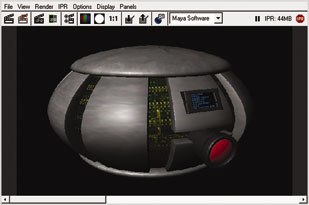In the latest excerpt from Learning Maya 7 | Foundation, Marc-AndrGuindon and Cathy McGinnis continue a three-part series on rendering.

In this lesson, you will set up materials and textures for the orb. You will explore the makeup of a typical shading network, including its material node and any texture maps.
This lesson will make extensive use of the Interactive Photorealistic Renderer (IPR) found in Maya. This tool allows you to create a rendering of the scene that can then be used to interactively update changes to the scenes lighting and texturing. You will see how fast and intuitive it is to texture in Maya using IPR.
In this lesson, you will learn h ow to render a region; how to display snapshots; how to open and save your rendered images; how to display an images alpha channel; how to set up the IPR; how to make connections in the Hypershade; how to enable High Quality Rendering in a viewport.
IPR
To give you access to interactive updating capabilities, you will set up an IPR rendering. An IPR rendering creates a special image file that stores not only the pixel information about an image but also data about the surface normals, materials and objects associated with each of these pixels. This information is then updated as you make changes to your scenes shading.

1. IPR set up
-
From the Render View panel, click on the Render Globals button.
-
Click on the Maya Software tab.
-
From the Anti-aliasing Quality section, set Quality to Production Quality.
For IPR, you can use the best settings if desired. Your initial IPR rendering will be slower but the interactive updates will still be fast.
- Close the Render Globals window.
2. IPR render
-
From your Render View panel, select IPR > IPR Render > persp.
Now what seems to be a regular rendering of the scene appears. Notice the message at the bottom of the Render View saying Select a region to begin tuning.
- Click+drag to select an area of the IPR rendering that will cover the entire orb. This is the area that will be updated as you make changes.
Note: You can still change the region by click+dragging again in the Render View.

3. Tweak your materials
In your Hypershade panel, graph the metalBlinn shader group.
-
Drag the metalFile onto the metalBlinn material and drop it in the specularColor attribute.
- Drag the metalFile onto the metalBlinn material and drop it in the bump map attribute.
Notice how the IPR updates every time you bring a change to the shading group.
-
Select the bump2D node and change the Bump Depth to 0.1.
- Graph the circuitsBlinn shader in the Hypershade and map the circuitsFile into the bump map attribute for this material as well.
Note: To clear the Hypershade Work Area, click on the Eraser button.

4. Drag and drop feature
-
Create a new Phong material.
- With your MMB, drag the new Phong in the Render View and drop it on the tube.
Dropping a material directly in the IPR has the same effect as dropping it on a model in a viewport.
Find out more about building an orb and other topics in Learning Maya 7 | Foundation by Marc-André Guindon and Cathy McGinnis: Alias|Learning Tools, 2005. 642 pages with illustrations and DVD. ISBN: 1-894893-74-3 ($69.95). Check back to VFXWorld frequently to read new excerpts.
Primary author Marc-André Guindon is the founder of Realities Studio, a Montreal-based production facility. An advanced user of both Maya and Alias MotionBuilder, Marc-André and Realities have partnered with Alias on several projects, including The Art of Maya, Learning Maya 6 | MEL Fundamentals and the series Learning Maya 7. He had developed plug-ins and tools for films and games, including the Outlaw Game series. He served as td on XXX2, State of the Union, Scooby-Doo 2 and Dawn of the Dead.
Contributing author Cathy McGinnis is an Alias certified instructor teaching at the Media Design School in Auckland, New Zealand. Cathy was previously a technical product specialist for Alias, specializing in rendering in both Maya and mental ray for Maya. She has been a contributor to several Alias publications, including Learning Maya | Rendering and Learning Maya | Foundation.







